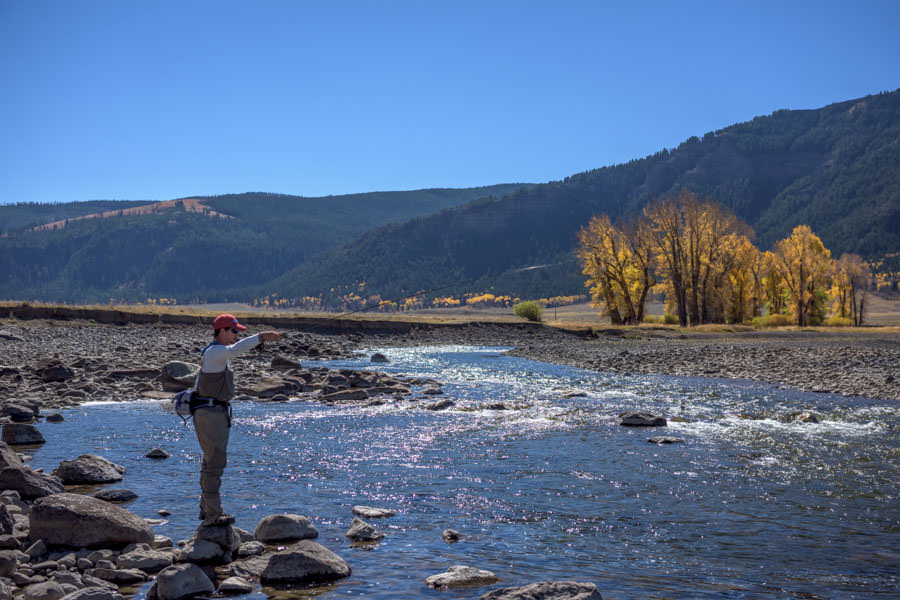
Fall is here and the weekend forecast looks ideal for some very good Blue Winged Olive and streamer fishing. Get out there if you can...but bring the rain jackets and quality gear!
Nearly every river and creek in southwest Montana is on the menu and the potential for some of the biggest trout of the season exists as large brown trout become more aggressive.
If you are planning to go fly fishing in Montana soon, be sure to read some of our recent blog posts, such as 6 (Plus One) Essential Flies for Fall Fly Fishing in Montana, The Mayfly You Need to Know, and plenty of others on our blog.
Our guides are finding plenty of trout...and some of them are big, including a few recent 24-inch plus brown trout from the Madison River. Hatches of Blue Winged Olives should now be a daily occurrence and anglers wanting to swing for the fences for a trophy-sized brown can feel good about being trying to be in the right place at the right time for it all to come together.
Overview
For subsurface try big patterns that imitate small bait fish like sculpins along with smaller attractor nymphs that are pretty general. The productive fishing hours are late morning into the late afternoon with action quickly dwindling as the sun sets. Fishing conditions and hatches of Blue Winged Olives are going to be entirely dependent on localized weather patterns. Blue Winged Olive hatches will most likely occur every day, but their frequency will vary. Streamer fishing is going to be the focus of many anglers right now as brown trout are going to be at the peak of their aggression as they gear up for spawning.
Hatches
Generally speaking, Blue Winged Olives are the main hatch to fish in the fall. They will likely hatch regardless of weather but the intensity will vary based on short-term weather. In fall, BWOs are less frequent but hatches can be very intense just before, during, and after a significant change from warm, sunny weather to cold, slightly rainy and overcast weather. Often the least enjoyable weather days are the best BWO fishing days.
Fly selection
For dry flies choose small mayfly patterns. For nymphing trout will start moving for a lot of sculpins but if nocturnal stones are around a size 6 rubber legs will still produce. For dropper nymphs try smaller patterns on more pressured waters. Although the beatis aren’t hatching in force, they are an important food source for the trout as nymphs and small size 20 beatis emergers can be deadly this time of year. Smaller droppers and finer flourcarbon tippet sometimes makes a difference but no need to drop to anything below 5x unless you are on a spring creek.
Parachute Adams in sizes 12-18
Comparaduns in sizes 12-18
Royal PMX in sizes 10-12
Beadhead Little Green Machines in olive or natural in sizes 16 to 22
Pat's Rubberlegs in contrasting colors in sizes 6-12
Beadhead Pheasant Tails in flashback or natural in sizes 12-22
Firebead or hot bead SJ wormies in sizes 8-12
Beadhead Perdigons in natural, olive, peacock, black, in sizes 16 to 22
Sawyer Pheasant Tails in sizes 16 to 22
Home Invaders in darker/contrasting colors in size 2 - 10
Sculpzillas in black, olive, or brown in size 2- 10
Sparkle Minnows in a variety if colors in size 2 - 10
Elk Hair Caddis in sizes 10-18
Buzzballs in sizes 16-22
Your favorite go-to streamer pattern
Reading water
The the slow slicks and big seams were beginning to hold fish and keep an eye out for this type of water because as temps keep dropping they will begin moving back into the softer water, slow seems and foam eddies.
Looking for More Great Content?
6 (PLUS ONE) Essential Flies for Fall Fishing in Montana
7 Best Tips for Walk and Wade Fishing in Montana
6 Great Tips for Fishing Hoppers, Ants, Beetles
Dry-Dropper Rigs: When to Use and When Not to Use
How to Rig and Fish a Dry-Dropper Set Up for Montana Fishing
